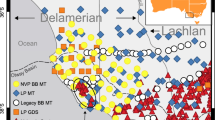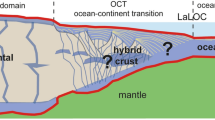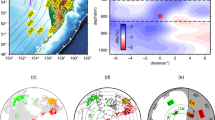Abstract
Volatiles that are transported by subducting lithospheric plates to depths greater than 100 km are thought to induce partial melting in the overlying mantle wedge, resulting in arc magmatism and the addition of significant quantities of material to the overlying lithosphere1. Asthenospheric flow and upwelling within the wedge produce increased lithospheric temperatures in this back-arc region, but the forearc mantle (in the corner of the wedge) is thought to be significantly cooler. Here we explore the structure of the mantle wedge in the southern Cascadia subduction zone using scattered teleseismic waves recorded on a dense portable array of broadband seismometers. We find very low shear-wave velocities in the cold forearc mantle indicated by the exceptional occurrence of an ‘inverted’ continental Moho, which reverts to normal polarity seaward of the Cascade arc. This observation provides compelling evidence for a highly hydrated and serpentinized forearc region2, consistent with thermal and petrological models of the forearc mantle wedge. This serpentinized material is thought to have low strength and may therefore control the down-dip rupture limit of great thrust earthquakes, as well as the nature of large-scale flow in the mantle wedge.
This is a preview of subscription content, access via your institution
Access options
Subscribe to this journal
Receive 51 print issues and online access
$199.00 per year
only $3.90 per issue
Buy this article
- Purchase on Springer Link
- Instant access to full article PDF
Prices may be subject to local taxes which are calculated during checkout



Similar content being viewed by others
References
Gill, J. Orogenic Andesites and Plate Tectonics (Springer, New York, 1981)
Fyfe, W. S. & McBirney, A. R. Subduction and the structure of andesitic volcanic belts. Am. J. Sci. A 275, 285–297 (1975)
Nabelek, J. L. et al. A high-resolution image of the Cascadia subduction zone from teleseismic converted phases recorded by a broadband seismic array. Eos 74, 431 (1993)
Bostock, M. G., Rondenay, S. & Shragge, J. Multiparameter two-dimensional inversion of scattered teleseismic body waves 1. Theory for oblique incidence. J. Geophys. Res. 106, 30771–30782 (2001)
Rondenay, S., Bostock, M. G. & Shragge, J. Multiparameter two-dimensional inversion of scattered teleseismic body waves 3. Application to the Cascadia 1993 data set. J. Geophys. Res. 106, 30795–30807 (2001)
Peacock, S. M. Large-scale hydration of the lithosphere above subducting slabs. Chem. Geol. 108, 49–59 (1993)
Fisher, A. T. Permeability within basaltic oceanic crust. Rev. Geophys. 36, 143–182 (1998)
Peacock, S. M. & Hyndman, R. D. Hydrous minerals in the mantle wedge and the maximum depth of subduction thrust earthquakes. Geophys. Res. Lett. 26, 2517–2520 (1999)
Ulmer, P. & Trommsdorff, V. Serpentine stability to mantle depths and subduction-related magmatism. Science 268, 858–861 (1995)
Blackwell, D. D. et al. Heat flow in the Oregon Cascade Range and its correlation with regional gravity, Curie point depths, and geology. J. Geophys. Res. 95, 19475–19493 (1990)
Lewis, T. J. et al. Subduction of the Juan de Fuca plate: thermal consequences. J. Geophys. Res. 93, 15207–15227 (1988)
McMahon, A. The Thermal Structure of the Cascadia Subduction Zone: Implications for Arc Magma Generation Thesis, Arizona State Univ., Tempe (2001)
Christensen, N. Poisson's ratio and crustal seismology. J. Geophys. Res. 101, 3139–3156 (1996)
Christensen, N. Elasticity of ultrabasic rocks. J. Geophys. Res. 71, 5921–5931 (1966)
Ahrens, T. J. & Schubert, G. Gabbro-eclogite reaction rate and its geophysical significance. Rev. Geophys. Space Phys. 13, 383–400 (1975)
Hacker, B. R. et al. in Subduction Top to Bottom (ed. Bebout, G. E.) 105–111 (American Geophysical Union, Washington DC, 1996)
Kamiya, S. & Kobayashi, Y. Seismological evidence for the existence of serpentinized wedge mantle. Geophys. Res. Lett. 27, 819–822 (2000)
Graeber, F. M. & Asch, G. Three-dimensional models of P wave velocity and P-to-S velocity ratio in the southern central Andes by simultaneous inversion of local earthquake data. J. Geophys. Res. 104, 20237–20256 (1999)
Fryer, P. Evolution of the Mariana convergent plate margin System. Rev. Geophys. 34, 89–125 (1996)
Tichelaar, B. W. & Ruff, L. J. Depth of seismic coupling along subduction zones. J. Geophys. Res. 98, 2017–2037 (1993)
Oleskevich, D. A., Hyndman, R. D. & Wang, K. The updip and downdip limits to great subduction earthquakes: thermal and structural models of Cascadia, south Alaska, SW Japan and Chile. J. Geophys. Res. 104, 14965–14991 (1999)
Escartin, J., Hirth, G. & Evans, B. Strength of slightly serpentinized peridotites: Implications for the tectonics of oceanic lithosphere. Geology 29, 1023–1026 (2001)
Raleigh, C. B. & Paterson, M. S. Experimental deformation of serpentinite and its tectonic consequences. J. Geophys. Res. 70, 3965–3985 (1965)
Reinen, L. A. Seismic and aseismic slip indicators in serpentinite gouge. Geology 28, 135–138 (2000)
Acknowledgements
We thank J. Nabelek and co-workers at Oregon State University for collecting the data set, and R. Benson for facilitating access to the IRIS DMC data archive.
Author information
Authors and Affiliations
Corresponding author
Ethics declarations
Competing interests
The authors declare that they have no competing financial interests.
Rights and permissions
About this article
Cite this article
Bostock, M., Hyndman, R., Rondenay, S. et al. An inverted continental Moho and serpentinization of the forearc mantle. Nature 417, 536–538 (2002). https://doi.org/10.1038/417536a
Received:
Accepted:
Issue Date:
DOI: https://doi.org/10.1038/417536a
This article is cited by
-
An introductory review of the thermal structure of subduction zones: I—motivation and selected examples
Progress in Earth and Planetary Science (2023)
-
Si- versus Mg-metasomatism at the crust–mantle interface: insights from experiments, natural observations and geochemical modeling
Progress in Earth and Planetary Science (2023)
-
Relationship Between the High-Amplitude Magnetic Anomalies and Serpentinized Fore-Arc Mantle in the Cascadia Subduction Zone
Pure and Applied Geophysics (2023)
-
Fluid transport and storage in the Cascadia forearc influenced by overriding plate lithology
Nature Geoscience (2022)
-
Halogens in serpentinised-troctolites from the Atlantis Massif: implications for alteration and global volatile cycling
Contributions to Mineralogy and Petrology (2022)
Comments
By submitting a comment you agree to abide by our Terms and Community Guidelines. If you find something abusive or that does not comply with our terms or guidelines please flag it as inappropriate.



